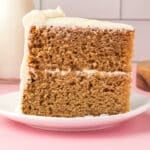Applesauce Spice Cake
Two-layer applesauce spice cake is moist and tender because of buttermilk. Top with a homemade cream cheese frosting. Simply beautiful!
Servings: 15
Calories: 455kcal
Ingredients
FOR THE CAKE:
- 2 ½ cups all-purpose flour
- 2 teaspoons ground cinnamon
- 2 teaspoons baking powder
- 1 teaspoon baking soda
- 1 teaspoon ground ginger
- 1 teaspoon ground nutmeg
- ½ teaspoon salt
- ¼ teaspoon ground cloves
- 1 ½ cups light brown sugar packed
- ½ cup granulated sugar
- ¾ cup vegetable oil
- 4 large eggs
- 1 cup unsweetened applesauce
- 1 teaspoon vanilla extract
- 1 cup buttermilk full fat
FOR THE FROSTING:
- 8 ounces cream cheese softened
- ½ cup unsalted butter 4 oz, room temperature
- 4 cups powdered sugar
Instructions
MAKE THE CAKE:
- Preheat oven to 350ºF. Spray two round 8-inch cake pans well with non-stick cooking spray then cut out two circles of parchment paper to go in bottom of each pan. Set pans aside for now.
- In a medium bowl, whisk together flour, cinnamon, baking powder, baking soda, ginger, nutmeg, salt and cloves. Set aside for now. 2 ½ cups all-purpose flour, 2 teaspoons ground cinnamon, 2 teaspoons baking powder, 1 teaspoon baking soda, 1 teaspoon ground ginger, 1 teaspoon ground nutmeg, ½ teaspoon salt, ¼ teaspoon ground cloves
- In a separate large bowl, beat together brown sugar, granulated sugar, vegetable oil, eggs, applesauce and vanilla extract. Beat just until mixed (about 1 minute). 1 ½ cups light brown sugar, ½ cup granulated sugar, ¾ cup vegetable oil, 4 large eggs, 1 cup unsweetened applesauce, 1 teaspoon vanilla extract
- Add half the dry ingredients to the wet ingredients and beat just until mixed, then add all the buttermilk to the wet mixture and beat just until combined. Add the last half of the flour mixture to the wet mixture and beat just until mixed. Do not overmix. 1 cup buttermilk
- Pour batter evenly into each cake pan. If you have a food scale, this can be a handy tool to make sure you have the same amount of batter in each pan. Bake cakes for 40-45 minutes or until toothpick inserted in middles of cakes comes out clean. When testing for doneness with a toothpick, there should be no raw batter on the toothpick.
- Let cakes cool in cake pans on top of stove for 20 minutes before removing from pans and transferring to wire rack to cool completely before frosting. If cake is sticking to sides of pan, lightly run a table knife around the inside of the pan to loosen the cake.
MAKE THE FROSTING:
- In a large bowl, beat cream cheese until smooth. Beat in unsalted butter and vanilla extract until smooth. Beat in confectioners’ sugar until smooth (about 2 minutes). 8 ounces cream cheese ½ cup unsalted butter, 4 cups powdered sugar
- Before layering cakes, use a serrated knife to cut off raised tops of cakes so you have two flat layers. Start by placing one layer of cooled cake onto cake plate or cardboard cake circle. Add icing to the top of this layer that will be used to stick the two layers together. This doesn’t have to be a thick layer.
- Next put the second cake layer on top of the first layer. This second layer should have the bottom facing up since that will be a smooth top.
- Using an angled icing spatula, frost all sides and top with a thin layer of frosting. This is called a crumb coat and will help seal in the crumbs before the top coat of frosting. Put the cake in the freezer for about 10 minutes to allow this to harden before adding the final layer of frosting.
- Remove cake from freezer and add a second thicker layer of icing to sides and top of the cake. Use a cake side scraper (optional) to smooth out sides and top of cake. Optional: use an icing bag and star tip to make dollops of frosting along the top and bottom rims of cake.
Notes
- Use our cake release in the baking pans to ensure the cakes come out cleanly.
- This cake is great with added raisins or nuts such as pecans or walnuts.
- Use a food scale to get even amounts of batter in both pans. If you don’t have one, you can just eyeball it, but a food scale is great for getting even layers.
- Another way to get flat layers without domed tops is to use Wilton Bake Even Cake strips. It sounds odd, but they really work!
- Store cake leftovers in an airtight container in the fridge for up to 5 days.
Nutrition
Calories: 455kcal | Carbohydrates: 80g | Protein: 5g | Fat: 13g | Saturated Fat: 8g | Polyunsaturated Fat: 1g | Monounsaturated Fat: 4g | Trans Fat: 1g | Cholesterol: 84mg | Sodium: 244mg | Potassium: 185mg | Fiber: 1g | Sugar: 62g | Vitamin A: 496IU | Vitamin C: 1mg | Calcium: 91mg | Iron: 2mg
